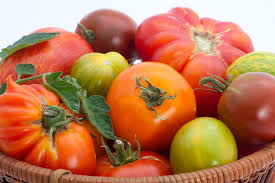Tomatoes are ubiquitous in the American diet. They appear in sauces, salads, juices, soups and elsewhere. Their prevalence is good news; tomatoes are healthful as well as tasty and versatile. They are especially lauded for their cardiovascular benefits.

“Tomatoes are low in calories, (about 25 calories per one medium-size tomato) yet filled with nutrition,” said Heather Mangier, a Pittsburgh-based registered dietitian and nutritionist, health author and spokesperson for the Academy of Nutrition and Dietetics. They are good sources of several vitamins, minerals and phytonutrients, especially the carotenoid lycopene, which gives tomatoes their vibrant red color.
However, while people in North America were shunning tomatoes, indigenous peoples in South America, as well as Europeans, were chowing down. Tomatoes are native to the region of Colombia, Ecuador, Peru, Bolivia and Chile. Around the 1500s, Spanish conquistadors began shipping them around the globe.
Italians were among the first Western populations to embrace the tomato. In Italy, a tomato is a golden apple, which probably refers to yellow- or orange-colored tomatoes.
Fruit or vegetable?
Whether a tomato is classified as a fruit or a vegetable depends on whom you ask. A botanist would tell you that a tomato is a fruit as well as a berry because it develops from a single fertilized ovary.

A chef or U.S. politician, however, might disagree. In 1886, in a tax lawsuit with a tomato importer, the Supreme Court ruled that tomatoes are vegetables, according to National Geographic. The U.S. Department of Agriculture lists tomatoes and tomato products in the vegetable group in the National Nutrient Database. But the primary reason we think of tomatoes as vegetables is their savory taste, which we associate with main meals rather than dessert or snacks.
There are hundreds of varieties of tomatoes. They can bered, pink, yellow, orange/tangerine, green, purple, brown, or black, according to World’s Healthiest Foods. Among the largest varieties are beefsteak and beef master tomatoes. Roma tomatoes are medium in size, and cherry and grape tomatoes are small.
The term “heirloom tomatoes” has several different meanings. Traditionally, the term refers to seeds that get handed down from generation to generation within a family. But there are also “commercial heirloom” tomatoes in the marketplace, which are often produced from cross-breeding and open pollination.
Nutrient profile
“Tomatoes are high in fiber and a good source of vitamin A, C, B2 … folate and chromium,” said Mangieri. The vitamins act as antioxidants, which neutralize free radicals to stop the condition of oxidative stress. Free radicals cause cell damage and disruption that can contribute to diseases. The minerals play important roles in ensuring the body functions properly.

“There are also a variety of carotenoids [including lycopene and beta-carotene], the phytonutrients that are thought to play a role in chronic disease prevention,” said Mangieri. Mangieri noted that cooking tomatoes increases the amount of lycopene you absorb.
Here are the nutrition facts for tomatoes, according to the U.S. Food and Drug Administration, which regulates food labeling through the National Labeling and Education Act:
Heart health
Lycopene is thought to reduce the risk of heart disease, said Mangieri. A 2011 review of studies on lycopene and heart disease, published in Current Medicinal Chemistry, found that most research supports the positive relationship between lycopene intake or low-dose supplementation and reduced risk of heart disease. This is likely due to two of lycopene’s actions involving fats in the bloodstream. Lycopene, and some other phytonutrients, can lower lipid peroxidation. Lipid peroxidation is when fats in the blood are damaged by oxygen and in excess can trigger gradual blocking of blood vessels. Lycopene has also been shown to result in lowered LDL (bad) cholesterol and triglyceride levels.
Beta-carotene may help lower the risk of metabolic syndrome, at least in middle-age and elderly men, a study published in the Journal of Nutrition found. Metabolic syndrome is characterized by high blood pressure, high blood sugar, abnormal cholesterol levels and excess fat around the waist. It is often considered a precursor to heart disease and diabetes. In the study, men with the most beta-carotene intake had the lowest risk of metabolic syndrome, as well as reduced waist circumference. Scientists suspect this is the result of beta-carotene’s antioxidant activities.
Phytonutrients in tomatoes can also help reduce excessive platelet clumping, which can lead to unwanted clotting and blood vessel blockages, according to a study of 19 fruits and 26 vegetables published in Blood Coagulation. The study found tomatoes to be among the most effective foods in this regard.
“A diet rich in potassium helps to offset some of sodium’ harmful effects on blood pressure,” said Mangieri. This is because potassium promotes vasodilation, or widening of the blood vessels, which decreases blood pressure. One study of 12,000 adults, published in Archives of internal Medicine, showed that those who consumed 4,069 mg of potassium each day lowered their risk of cardiovascular disease and ischemic heart disease by 37 percent and 49 percent, respectively, compared to those who took 1,793 mg per day.
Antioxidant power
Though most of the phytonutrients and vitamins in tomatoes have potent antioxidant properties, lycopene is a standout. In a test tube study published in Archives of Biochemistry and Biophysics, researchers found that lycopene was most effective at deactivating singlet oxygen (a harmful free radical) of all the carotenoids. This could be because lycopene has a unique molecule shape that is highly effective in deactivating free radicals.
Strong bones

Lycopene may promote bone health and help prevent the development of osteoporosis. A study published in the Journal of Bone and Mineral Research found that participants with higher levels of lycopene in their blood were less likely to experience hip or nonvertebral fracture. Furthermore, a study published in Osteoporosis international found that postmenopausal women who added lycopene to their diets for four months saw decreased bone resorption (breakdown of bones).
Eyesight
Tomatoes contain both vitamin A and beta-carotene, which can turn into vitamin A when digested. Vitamin A is known to be necessary for vision. It is required to keep the retina working correctly and for low-light and color vision, according to the Linus Pauling Institute at Oregon State University. It also plays a role in eye development.

Tomatoes’ vitamin C and vitamin A content is good for your skin. According to the Linus Pauling Institute at Oregon State University, vitamin C is necessary for collagen production, which keeps your skin looking youthful and aids in wound healing, and vitamin A is a compound in retinoids, which are popular in anti-aging skin treatments.
Beta-carotene may help protect against sunburn, according to a meta-analysis published in Photochemistry and Photobiology. The researchers looked at several studies and found that participants who took beta-carotene supplements for 10 weeks had lower rates of sunburn. For each month of additional supplementation, the protection level increased.
Cancer prevention
A 1999 review published in the Journal of the National Cancer Institute found that tomatoes and lycopene were associated with reduced risk of cancers of the prostate, lung, stomach, pancreas, colon and rectum, esophagus, oral cavity, breast and cervix. The associations were strongest for prostate, lung and stomach cancers.
A 2015 review published in the Journal of Cancer Prevention found that lycopene lowered the risk of stomach cancer through its antioxidant actions. Researchers looked primarily at participants who smoked, suffered from chronic inflammation or had elevated levels of stomach bacteria Helicobacter pylori, though they noted that poor diet and family history could also be risk factors lessened by lycopene.
Stroke
Lycopene may decrease stroke risk, at least in men. According to a 12-year study published in Neurology, middle-age men with the highest levels of lycopene in their blood had a 55 percent reduced rate of any kind of stroke. They had a 59 percent reduced rate of strokes from blood clots, the most common kind.
Cognition
The beta-carotene in tomatoes may help protect against cognitive decline. A study published in JAMA found that men who took beta-carotene supplements long term — the study covered 18 years — were less likely to lose cognitive abilities. Men who took beta-carotene supplements for only one year did not see results. The authors speculate that the long-term results were the result of beta-carotene acting as an antioxidant, but could also be the result of lifestyle factors or other characteristics. More studies are needed.
Additionally, some studies have linked diets with tomatoes to a reduced risk of neurological diseases, including Alzheimer’s disease, according to World’s Healthiest Foods.
Asthma
Some small-scale studies suggest that the lycopene content in tomatoes may help asthma sufferers. One study, published in Free Radical Research, found that taking tomato extract reduced lung inflammation. Another study, published in Allergy, found that a daily dose of lycopene for a week reduced exercise-induced asthma in 55 percent of participants. Researchers suspect this was because of an antioxidant effect in the lungs.
Nerve, muscle and cell health
“Tomatoes are rich in potassium, a mineral that helps nerves and muscles communicate,” said Mangieri. For example, potassium helps regulates your heart beat. “It helps move nutrients into cells and waste products out of cells,” she added.
Risks of eating tomatoes
Like many fruits and vegetables with edible skins, tomatoes are often covered in pesticides. Tomatoes ranked ninth on the Environmental Working Group’s annual Dirty Dozen list, which compiles the fruits and vegetables with the most pesticides. Try to buy organic tomatoes if you can.
The leaves of a tomato plant should not be eaten. They contain large concentrations of alkaloids, according to World’s Healthiest Foods.
If eaten in reasonable amounts, tomatoes should produce no serious side effects. If you eat an abundance of tomatoes daily, however, you may experience problems from having too much lycopene or potassium. Consuming more than 30 mg of lycopene daily could potentially cause nausea, diarrhea, indigestion and bloating, according to the American Cancer Society.
People with serious hyperkalemia, or too much potassium in their blood, should talk to their doctors about the appropriate amount of tomato consumption. According to the National Institutes of Health, hyperkalemia can result in irregular heartbeats and other cardiovascular problems, as well as reduced muscle control.
Enjoying tomatoes
Mangieri, a self-described tomato lover, provided some tips on incorporating more tomatoes into your diet. She said:
- Tomatoes are definitely better fresh, but that does not mean that you can’t enjoy them in the winter months. Place fresh tomatoes in zip-lock bags and freeze them for the winter. They can be used to make soups, stews and chili during the colder months.
- Add a layer of fresh, sliced tomatoes to lasagna. It’s a great way to boost the nutrients of this dish.
- Eat baby tomatoes with hummus or low-fat dressing.
- Fresh tomatoes sliced with fresh mozzarella, topped with fresh basil then drizzled with olive oil.
